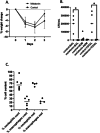Efficacy of melatonin treatment in a cystic fibrosis mouse model of airway infection
- PMID: 39805903
- PMCID: PMC11730334
- DOI: 10.1038/s41598-025-85948-6
Efficacy of melatonin treatment in a cystic fibrosis mouse model of airway infection
Abstract
Approaches to mitigate the severity of infections and of immune responses are still needed for the treatment of cystic fibrosis (CF) even with the success of highly effective modulator therapies. Previous studies identified reduced levels of melatonin in a CF mouse model related to circadian rhythm dysregulation. Melatonin is known to have immunomodulatory properties and it was hypothesized that treatment with melatonin would improve responses to bacterial infection in CF mice. Data demonstrate that CF mice (G542X/G542X) treated with melatonin (10 µg/mL) in drinking water for 10 weeks had improved responses to airway infection with a clinical isolate of Pseudomonas aeruginosa. Melatonin-treated mice exhibited improved bacterial clearance, reduced inflammatory markers. Mice treated in drinking water for 1 week had improved bacterial clearance but no improvement in inflammation. Wild type (WT) control mice showed no response to melatonin treatment suggesting melatonin is eliciting a CF-specific response in this model. The efficacy of direct melatonin (1 µM) treatment to the airways was also tested and found to be ineffective. In conclusion, long-term systemic treatment with melatonin is an effective therapy in a CF mouse model that normalizes the response to airway infection to a WT pattern.
© 2025. The Author(s).
Conflict of interest statement
Declarations. Competing interests: The authors declare no competing interests.
Figures








Similar articles
-
Efficacy of Rhesus Theta-Defensin-1 in Experimental Models of Pseudomonas aeruginosa Lung Infection and Inflammation.Antimicrob Agents Chemother. 2017 Jul 25;61(8):e00154-17. doi: 10.1128/AAC.00154-17. Print 2017 Aug. Antimicrob Agents Chemother. 2017. PMID: 28559270 Free PMC article.
-
Evidence for the efficacy of aztreonam for inhalation solution in the management of Pseudomonas aeruginosa in patients with cystic fibrosis.Ther Adv Respir Dis. 2015 Feb;9(1):16-21. doi: 10.1177/1753465814561624. Ther Adv Respir Dis. 2015. PMID: 25471692 Review.
-
Azithromycin potentiates avian IgY effect against Pseudomonas aeruginosa in a murine pulmonary infection model.Int J Antimicrob Agents. 2021 Jan;57(1):106213. doi: 10.1016/j.ijantimicag.2020.106213. Epub 2020 Oct 23. Int J Antimicrob Agents. 2021. PMID: 33256950
-
Interleukin-17 Pathophysiology and Therapeutic Intervention in Cystic Fibrosis Lung Infection and Inflammation.Infect Immun. 2016 Aug 19;84(9):2410-21. doi: 10.1128/IAI.00284-16. Print 2016 Sep. Infect Immun. 2016. PMID: 27271746 Free PMC article.
-
The approach to Pseudomonas aeruginosa in cystic fibrosis.Semin Respir Crit Care Med. 2009 Oct;30(5):587-95. doi: 10.1055/s-0029-1238917. Epub 2009 Sep 16. Semin Respir Crit Care Med. 2009. PMID: 19760546 Review.
Cited by
-
Comparative Analysis of Melatonin and Polydeoxyribonucleotide: Possible Benefits of Co-Treatment Effects and Potential Synergistic Applicability.Int J Mol Sci. 2025 Jun 13;26(12):5703. doi: 10.3390/ijms26125703. Int J Mol Sci. 2025. PMID: 40565167 Free PMC article. Review.
References
Publication types
MeSH terms
Substances
Grants and funding
LinkOut - more resources
Full Text Sources
Medical
Molecular Biology Databases

